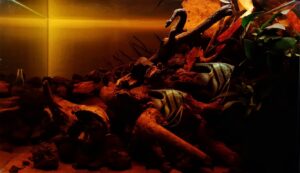A Tributary Somewhere in The Amazon
_st place in Biotope Aquarium Design Contest 2022

Volume of aquarium: 85.2 liters
Dimensions of aquarium: 59x38x38 cm
List of fishes: Pterophyllum scalare
Macrotocinclus affinis
List of plants: Anubias Barteri var. Nana
Description of Decorations and Substrate: Various locally collected driftwood and small branches similar color and texture to the nature biotope. Light colored river sand from a local river nearby. Black lava rocks stacked to mimic river bank in the nature biotope. Dried indian almond leaves.
Description of Equipment: DIY internal filter with 15 watt powerhead, course sponge filter, filter pads, filter wool amd pumice. Lights: Chihiros WRGB 1
Water Parameters: Temp 28.5c pH: 7.6 TDS: 152ppm
Additional Info: I do 50% weekly water change with cooled down water from boiling dried indian almond leaves to maintain the tint in the water. 3hrs lights on in the morning then another 3hrs lights on in the evening.
Aquarium video:
Description of the Area Surrounding the Biotope: Negro River, Portuguese Rio Negro, Spanish Río Negro, major tributary of the Amazon. It originates in several headstreams, including the Vaupés (Mapés) and the Guainía, which rise in the rain forest of eastern Colombia. The Guainía flows east and then arches northeast and southeast, forming the Colombian–Venezuelan border. Below its junction near San Carlos de Río Negro with the Brazo Casiquiare, a natural waterway that brings water from the Orinoco River in Venezuela, the river acquires the name Negro and enters Brazil. The Negro meanders generally east-southeastward, picking up the Branco River and other tributaries, to Manaus. There it joins the Solimões River to form the Amazon. Its length is about 1,400 miles (2,250 km), of which 850 miles (1,370 km) are in Brazil. It is navigable for about 450 miles (725 km) above its mouth. Although settlement along its banks is sparse, the river is a major transportation artery.Negro River, Portuguese Rio Negro, Spanish Río Negro, major tributary of the Amazon. It originates in several headstreams, including the Vaupés (Mapés) and the Guainía, which rise in the rain forest of eastern Colombia. The Guainía flows east and then arches northeast and southeast, forming the Colombian–Venezuelan border. Below its junction near San Carlos de Río Negro with the Brazo Casiquiare, a natural waterway that brings water from the Orinoco River in Venezuela, the river acquires the name Negro and enters Brazil. The Negro meanders generally east-southeastward, picking up the Branco River and other tributaries, to Manaus. There it joins the Solimões River to form the Amazon. Its length is about 1,400 miles (2,250 km), of which 850 miles (1,370 km) are in Brazil. It is navigable for about 450 miles (725 km) above its mouth. Although settlement along its banks is sparse, the river is a major transportation artery.
The clear jet-black colour of the Negro’s water, whence comes the river’s name, is caused by the decomposition of organic matter in marginal swamps and its low silt content. The black waters contrast dramatically with the yellowish silt-laden waters of the Branco and with the Amazon
Description of the Underwater Landscape of the Biotope: The clear jet-black colour of the Negro’s water, whence comes the river’s name, is caused by the decomposition of organic matter in marginal swamps and its low silt content. The black waters contrast dramatically with the yellowish silt-laden waters of the Branco and with the Amazon.
Description of the Habitat Parameters: Blackwater. Temp: 28c pH: 2.9-4.2
TDS: 7.1+-6.7
List of Fishes and Invertebrates Occurring in the Nature Biotope: Overall, the present compilation includes the records of 1,165 fish species for the Rio Negro basin, distributed in 17 orders (+ 2 groups considered incertae sedis), 56 families and 389 genera (Table 1, Suppl. material 1). The ichthyofauna was predominantly represented by members of the Ostariophysi (83.7% of the species) with the most diverse orders being the Characiformes (454 species; 39.0%), Siluriformes (416; 35.7%), Gymnotiformes (105; 9.0%) and Cichliformes (102; 8.8%). The other 13 orders (+ 2 groups incertae sedis) were represented by 88 species (7.5%) (Suppl. material 1). The most species-rich families were the Characidae (195 species), Loricariidae (125), Cichlidae (102), Doradidae (54), Auchenipteridae (48), Pimelodidae (44), Serrasalmidae (44), Apteronotidae (41) and Curimatidae (38). Together, these families account for 59.3% of the total richness found herein (Suppl. material 1).
List of Plants Found in the Nature Biotope: Cabomba aquatica ; Ceratopteris pteridoides ; Ceratopteris thalictroides ; Echinodorus horizontalis ; Echinodorus tenellus ; Eichhornia azurea ; Eichhornia crassipes ; Hydrocotyle leucocephala ; Limnobium laevigatum ; Mayaca fluviatilis
Threats to the Ecology of the Biotope: The aquarium design was created to let the people know of the beauty and importance of nature in our lives. The amazon provides 20% of our planet’s oxygen and freshwater and plays a major role in regulating climate around the planet. It is already facing numerous threats including illegal deforestation. Failibg to address these threats is certain to increase climate change and its effects around the world.
Sources of Information:
Texasclimatenews.org
Amazonasmagazine.com
Tank tested youtube channel
Amazon micrososm youtube channel
